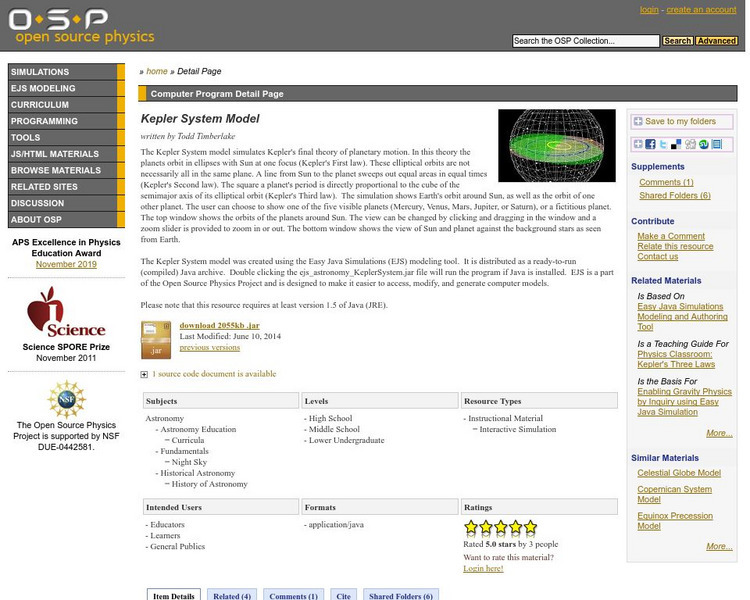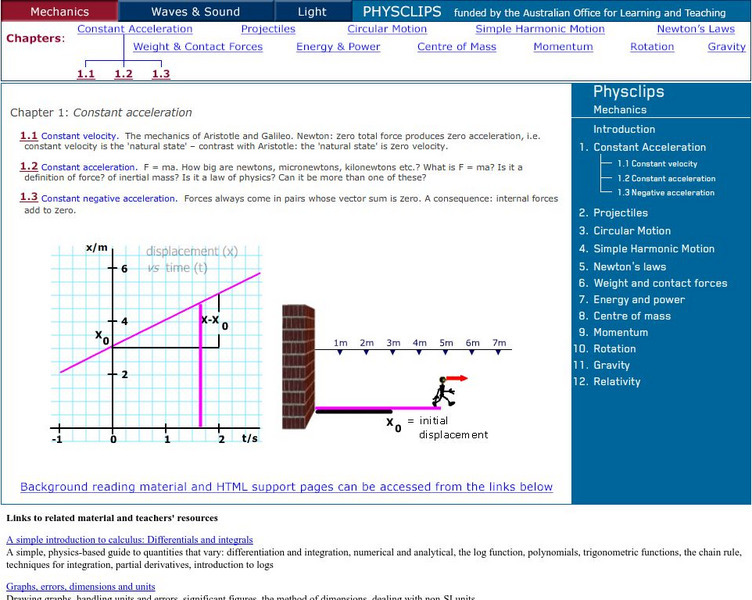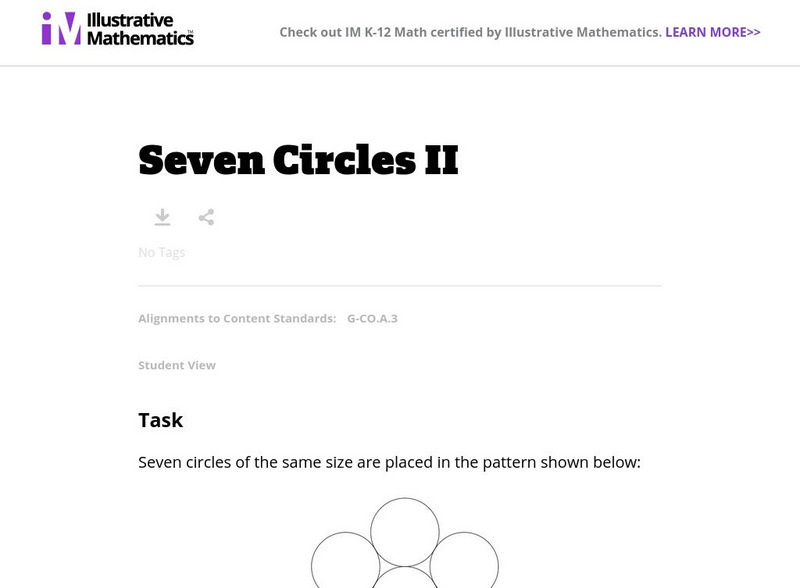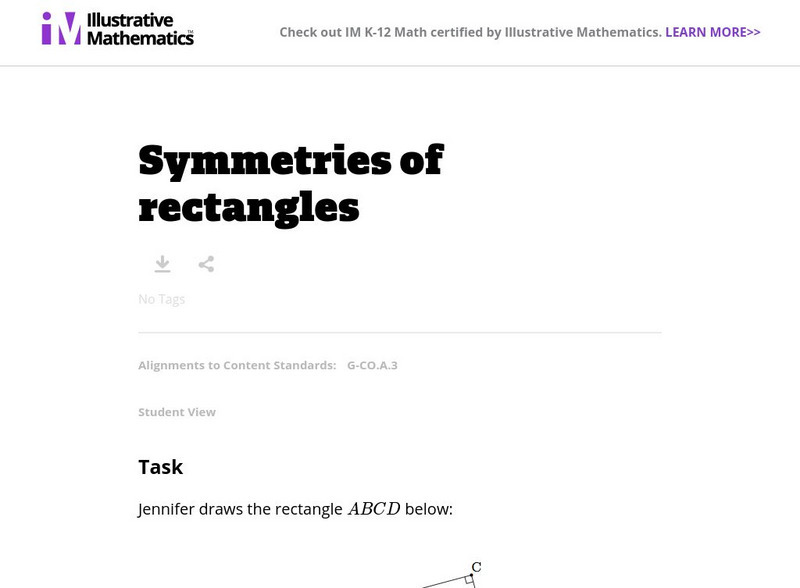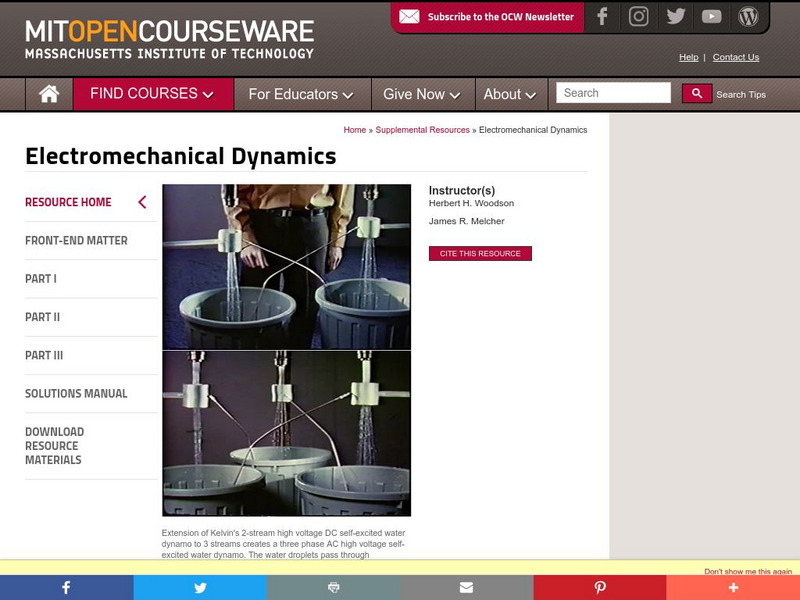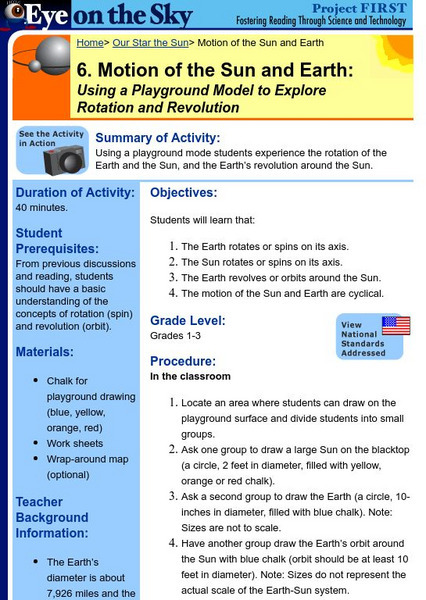NASA
Nasa: Gas Properties Definitions
Use this site to learn about basic gas properties including motion, viscosity, and compressibility. Includes links to activities for all ages.
Shodor Education Foundation
Shodor Interactivate: Transformations
This lesson shows elementary students how they can know that rigid motions like reflections, rotations, and translations create a shape congruent to the original.
American Association of Physics Teachers
Com Padre Digital Library: Open Source Physics: Kepler System Model
This site from Open Source Physics offers a file with a simulation of Kepler's theory of planetary motion, tested with the Earth rotating around the sun and another planet of the user's choosing. The download requires Java.
Texas Education Agency
Texas Gateway: Gyroscopic Effects: Vector Aspects of Angular Momentum
By the end of this section, you will be able to describe the right-hand rule to find the direction of angular velocity, momentum, and torque; explain the gyroscopic effect; and study how Earth acts like a gigantic gyroscope.
Other
Personal: The Laws of Motion
This personal site explains the physics of angular momentum and their application to flight. Part of a much larger site on the procedures, principles, and perceptions of flight.
Michigan Reach Out
Nasa: Soda Pop Can Hero Engine
Students explore all three parts of Newton's Laws of Motion by observing a spinning pop can.
Open Curriculum
Open Curriculum: Conservation of Angular Momentum
Students learn the concept of angular momentum of objects in two dimensions and how rotational motion is determined.
University of New South Wales (Australia)
University of New South Wales: School of Physics: Physclips
Physiclips thoroughly presents mechanics concepts with animations and film clips.
Georgia State University
Georgia State University: Hyper Physics: Kinetic Energy
This site from Georgia State University Physics Department defines kinetic energy and compares and contrasts it with other forms of energy. Provides an equation and links to further, more-detailed information.
CK-12 Foundation
Ck 12: Physics Simulation: Drawbridge
[Free Registration/Login Required] Learn about torque balance in the context of a medieval drawbridge using this interactive simulation. A PDF worksheet and a video tutorial are also available. [3:47]
Illustrative Mathematics
Illustrative Mathematics: G Co Seven Circles Ii
In this task, seven pennies are placed in a circle so that they are all touching one in the center and their neighbors. Students are asked to find as many rigid motions of the plane as they can which are symmetries of this configuration...
CK-12 Foundation
Ck 12: Physics Simulation: Walk the Tightrope
[Free Registration/Login Required] Understand the concept of rotational inertia [moment of inertia) by analyzing the motion of a circus tightrope walker using this interactive simulation. A PDF worksheet and a video tutorial are also...
Other
Astro Methods: Earth's Nutation Visualized
Nutation is a small cyclical motion superimposed upon the steady 26,000-year precession of the Earth's axis of rotation. It is mainly caused by the gravitational effect of the 18.6-year rotation period of the Moon's orbit. The main...
Illustrative Mathematics
Illustrative Mathematics: G Co Symmetries of Rectangles
This task examines the rigid motions which map a rectangle onto itself. The emphasis here is on careful reasoning using the definitions of reflections and rotations. Aligns with G-CO.A.3.
Massachusetts Institute of Technology
Mit: Open Course Ware: Supplemental Resources: Electromechanical Dynamics
College-level textbook highlighting the interaction of electromagnetic fields with media in motion. Types of electromechanical interactions discussed include rotating machinery, plasma dynamics, the electromechanics of biological...
Illustrative Mathematics
Illustrative Mathematics: 8.g Congruence of Alternate Interior Angles
Eighth graders are presented with a labeled drawing of two parallel lines intersected by a transversal line. They are asked to discuss congruency of angles when the picture is rotated about a point on the transversal. Aligns with 8.G.A.5.
American Association of Physics Teachers
Com Padre Digital Library: Open Source Physics: Gimbal Model
Simulate the pitch, roll and yaw of a 3D object on this Gimbal Model. Investigate the change at each independent axis by rotating it around specific points.
University of Colorado
University of Colorado: Ph Et Interactive Simulations: Balancing Act
Play the Balance Challenge game to see how various objects can be used to make a plank such as a teeter totter balance and how changing the position of an object will affect the motion and tilt of the plank.
Concord Consortium
Concord Consortium: Polar and Nonpolar Interface
Observe how molecules with hydrophilic and hydrophobic regions move in a mixture of oil and water, and pay attention to changes in potential energy over time. Move and rotate the molecules to see how they interact with their surrounding...
Other
Center for Science Education: Eye on the Sky: Motion of the Sun and Earth
Students model the interaction of the earth and the sun. The activity is designed for the playground. You will need chalk, but all the other worksheets are provided.
University of Guelph
University of Guelph: Physics Tutorials: Torque and Angular Acceleration
Words and equations are used to explain the relationship between angular acceleration and the torque exerted upon an object. Well-written; great graphics.
Other
Fearof Physics: Videos
Looking for some more explanantion on a topic covered in physics class? This site contains videos that explore some physics concepts. Videos are broken down by topics. Some videos also give examples on how to solve problems.
MadSci Network
Mad Scientist Network: How Can a Gyroscope Defy Gravity
Explanation of the seemingly gravity-defying feats of a gyroscope. Focuses on the reason behind its operation. Includes illustrations.
Khan Academy
Khan Academy: Conservation of Angular Momentum Review
Review how angular momentum is conserved if there is no external torque applied to a system. Specific scenarios are highlighted: system changing it rotational inertia, orbiting bodies, and rotational collisions.


